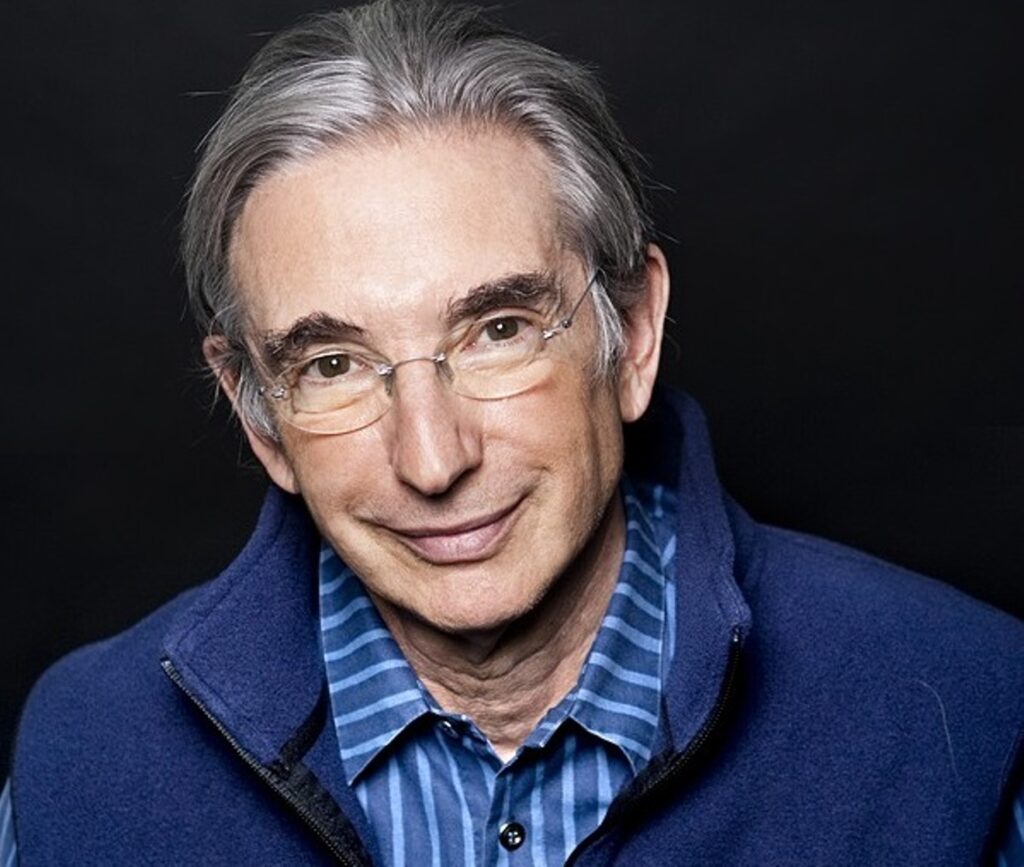Tilson Thomas returns, leads New World’s German program with vigor

Michael Tilson Thomas conducted the New World Symphony in music of Beethoven, Schumann and Schoenberg Saturday night. Photo: Michael McElroy
The New World Symphony’s program Saturday night encompassed a primer on one hundred years of German music. The path from Beethoven to Arnold Schoenberg was vast with many creative twists and innovations. But with artistic director laureate Michael Tilson Thomas returning to the podium and Emanuel Ax as stellar soloist, that road was vividly delineated. Despite lane closures on the causeways and check points to control spring-break crowds, the New World Center was packed with an enthusiastic audience.
It was heartening to see Tilson Thomas, who has been battling brain cancer, in such fine form. Except for stepping off the podium carefully, he seemed totally secure, walking briskly, standing erect on the podium and conducting with considerable vigor. Moreover, his music making was, if anything, more subtle and illuminating than ever.
Schoenberg’s Five Pieces for Orchestra, written in 1909 and revised four decades later, is one of the composer’s early ventures into atonality. Replete with cellular motifs and delicate sound patterns removed from traditional melody and harmony, these miniatures continue to astound and perplex listeners over a century after their creation.
One could not wish for a more lucid, intense, and musically articulate leader than Tilson Thomas to guide this score’s path- breaking journey. As has been so often the case, the New World fellows play with great concentration and precision when he is the guiding force. With the largest ensemble of the evening on stage, all sections were playing at peak form.
There was total clarity of individual lines with every instrumental detail emerging transparent in the opening “Presentiments.” Celeste and harp charmed the ear in the fragmentary, ghost-like thematic fragments of “The Past.” The initial outbursts in “Peripeteia” seemed almost like a burlesque of a fanfare. The section’s climaxes resounded with shattering impact. “The Obbligato Recitative” suggested a waltz, viewed through an atonal prism. This is music that Tilson Thomas clearly loves and his direction communicated its variety and daring to the audience, which responded to the performance with sustained applause.
This has been quite a week in South Florida for Emanuel Ax. Earlier, he gave a superb recital in Miami and played a Mozart concerto with the Palm Beach Symphony.
Turning to Beethoven’s Piano Concerto No. 3 in C minor, Ax again demonstrated his mastery in the music of the revolutionary genius from Bonn. Ax and Tilson Thomas are longtime collaborators and their artistic partnership was evident every step of the way in this exciting reading. There was both forward momentum and weight in the orchestral introduction, with the warmth of tone from the winds standing out. Ax has power to spare in his fingers but what distinguished his playing was the ability to make the piano sing. In the cadenza, Ax traversed both the titanic and lyrical sides of Beethoven’s musical persona.
He took a slower tempo in the Largo, bringing greater depth to the main melodic thread, supported by Tilson Thomas’ meticulous balancing. Even the seven basses were clearly audible and the accuracy and solidity of the horns was particularly notable. The Rondo moved at a crisp and energetic clip yet Ax still brought a Mozartean grace in the contrasting episodes and the coda flowed with feathery lightness.
Following a standing ovation, MTT joined Ax at the keyboard for an encore of the Andante from Mozart’s four-hand Sonata in D Major, K. 381, quipping “Old Jews play the old masters.” Their expert teamwork seemed like they had been playing duos together for years, and both smiled as they dispatched this elegant encore.
Tilson Thomas has led Schumann’s Symphony No. 1 in B-flat Major (“Spring”) several times before with New World. This performance of Schumann’s first major orchestral essay reflected his mature thoughts about the score.
The opening brass fanfare was taken at a deliberate pace, with notably burnished brass sonority. Incisive articulation wove through a brisk Allegro molto vivace but Tilson Thomas was not afraid to pull back for a more leisurely secondary theme and the stirring coda. His skill at drawing clean orchestral textures was so keen that even the triangle could be clearly heard over the full component.
After a slow movement shaped in long paragraphs, the Scherzo was attacked in robust fashion with Tilson Thomas sustaining the wit and whimsey of the trio. There was spring in the step of the principal motif of the finale. The coda radiated sheer joy and the entire concert displayed a master conductor and fine orchestra in top form.
The New World Symphony repeats the program 2 p.m. Sunday at New World Center in Miami Beach.
Michael Tilson Thomas conducts the New World Symphony in his own Agnegram, Tchaikovsky’s Symphony No. 4 and Copland’s Old American Songs with baritone Dashon Burton 8 p.m. March 16 at the Arsht Center in Miami. nws.edu
Posted in Performances
2 Responses to “Tilson Thomas returns, leads New World’s German program with vigor”
Leave a Comment
Sun Mar 10, 2024
at 10:47 am
2 Comments
Posted Mar 11, 2024 at 12:11 am by gail l harris
It was a very special evening ; one long to remember.
G. Harris
Posted Mar 11, 2024 at 6:58 pm by gail newman
What a wonderful night Saturday the 10th